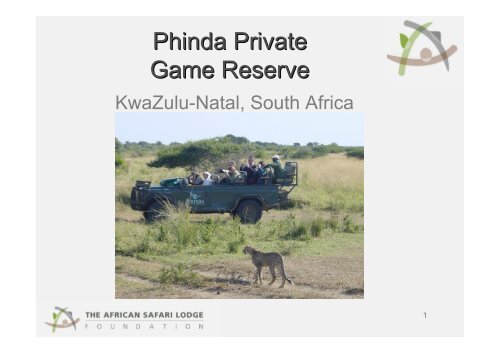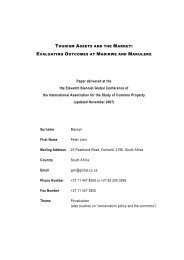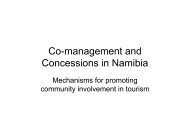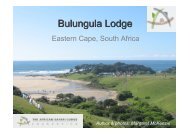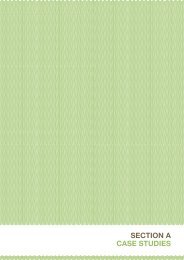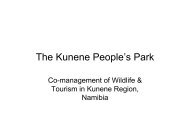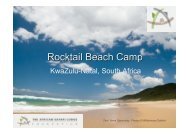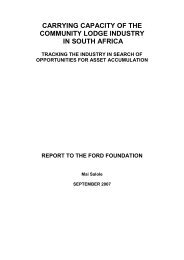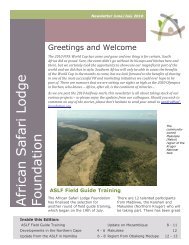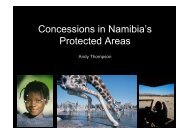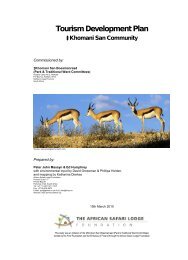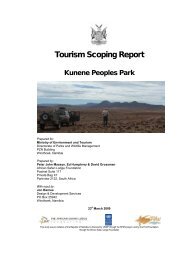Phinda Private Game Reserve - The African Safari Lodge Foundation
Phinda Private Game Reserve - The African Safari Lodge Foundation
Phinda Private Game Reserve - The African Safari Lodge Foundation
Create successful ePaper yourself
Turn your PDF publications into a flip-book with our unique Google optimized e-Paper software.
<strong>Phinda</strong> <strong>Private</strong><br />
<strong>Game</strong> <strong>Reserve</strong><br />
KwaZulu-Natal, South Africa<br />
1
Structure of case study<br />
• Overview of the initiative<br />
• Policy context<br />
• Planning and development issues:<br />
– Enterprise model and land tenure<br />
– Institutional arrangements<br />
• Tourism products and activities<br />
• Impacts of tourism<br />
– Environmental impacts and conservation<br />
– Social impacts, including training and skills development and<br />
stakeholders<br />
– Economic impacts, including value chain analysis, capital structure<br />
and commercial issues<br />
• Current issues and replicability<br />
2
Overview of the initiative<br />
• 7 luxury lodges operated by CCAfrica group on<br />
rehabilitated land in KwaZulu-Natal, South Africa.<br />
• CCAfrica owns 3667 ha, leases 11,226 ha, and<br />
traverses over the entire 23,335 ha Mun-ya-wana<br />
conservancy.<br />
• Operates interpretive photographic wildlife safaris,<br />
within a big 5 area & linkages to the coast<br />
• Corporate Social Responsibility program<br />
- the Africa <strong>Foundation</strong><br />
• Numerous conservation and local economic<br />
development initiatives<br />
Source: Kevin Pretorius and<br />
Andrew Campbell<br />
3
Policy context<br />
• 1997 White Paper on South <strong>African</strong> Land Policy: Land restitution –<br />
and land claims for land that people were displaced from during<br />
Apartheid<br />
• 1998 National Environmental Management Act: Governing<br />
environmental impacts of infrastructure development<br />
• 1998 Employment Equity Act / Tourism Black Economic<br />
Empowerment (BEE) Charter and Scorecard: Reporting on<br />
employment and training of historically disadvantaged individuals<br />
(black, women, disabilities)<br />
• Landowner policy for the reserve:<br />
– <strong>The</strong>re is a code of conduct; <strong>Phinda</strong> reserve manager manages Munyawana<br />
as a whole, including wildlife management, security, maintenance of fences<br />
under a reserve-wide environmental management plan<br />
– <strong>The</strong> community is consulted on management issues (alien plant control,<br />
bush clearing, road development, dam building).<br />
– <strong>The</strong> reserve constitution is currently being updated<br />
Source: Kevin Pretorius and<br />
Andrew Campbell<br />
4
Planning and development<br />
issues<br />
Context<br />
– <strong>The</strong> land was purchased as degraded farmland in 1991, and was<br />
rehabilitated and restocked with wildlife to provide a tourism<br />
attraction.<br />
– Part of land owned, part leased (but 2 nd land claim in progress on<br />
remainder). Forest lodge had an EIA because of location in sand<br />
forest. Other lodges were approved on the basis of information<br />
from the scoping phase (EIAs were not required).<br />
– <strong>The</strong> reserve constitution sets bed capacity limits at 1 bed per 75 ha<br />
(current density is 1 bed per 188 ha).<br />
Infrastructure – e.g. natural light, and cooling, waste disposal<br />
systems, construction materials, training craftspeople, décor,<br />
landscaping etc. Put fans on for aesthetic reasons. Lights on for<br />
aesthetic reasons inside (e.g. in chandeliers).<br />
– <strong>The</strong>re is a plan to construct and sell private lodges on the reserve<br />
called ‘<strong>African</strong> homesteads’ and EIAs will be required for each. 15<br />
sites are envisaged, with 4 bedrooms each (8 bed).<br />
Source: Kevin Pretorius and<br />
Andrew Campbell<br />
5
Reducing<br />
infrastructure<br />
impacts<br />
6
Planning & development issues:<br />
<strong>Phinda</strong> model and land tenure (1)<br />
Ownership<br />
Development<br />
Management<br />
Land and wildlife estate<br />
3667 ha owned by CCAfrica (awaiting<br />
notice under land claim)<br />
Communities own 6110 ha (Mnqobokazi)<br />
and 6550 ha (Makasa) and CCAfrica have<br />
72 year leases on each portion of land<br />
Additional 36 year leases on 1140 ha<br />
(Mnqobokazi) and 900 ha (Makasa)<br />
Traversing agreements on rest of land in<br />
reserve under other private ownership<br />
CCAfrica restocked wildlife and<br />
rehabilitated land<br />
Munyawana <strong>Reserve</strong> (CCAfrica reserve<br />
manager is head)<br />
Makhasa community<br />
owns Forest and Vlei<br />
lodges<br />
Rock/Mountain<br />
owned by CCAfrica<br />
Getty’s own Zuka<br />
Source: Kevin Pretorius and<br />
Andrew Campbell<br />
Commercial<br />
Infrastructure<br />
CCAfrica<br />
CCAfrica<br />
7
Planning & development issues:<br />
<strong>Phinda</strong> model and land tenure (2)<br />
Benefits of the model:<br />
• Released development capital from land<br />
• Plans for new lodges in Madagascar, Brazil, Peru, Costa Rica, more in Kenya<br />
and definitely +2 in Botswana, +2 in India<br />
• Benefits to communities – income and in equity<br />
• Long lease<br />
• Management control over wildlife and land<br />
Empowerment of local people:<br />
• <strong>The</strong> reserve director took local chiefs up to Tanzania to look at other lodges and<br />
give a wider perspective on CCAfrica<br />
• Some of the staff have now become shareholders(!)<br />
Source: Andrew Campbell<br />
8
Planning & development issues:<br />
Institutional Arrangements<br />
Mnqobokazi community<br />
Lessor 6110 ha land (72 year lease, following<br />
land claim)<br />
Lessor 1140 ha on 36 year lease<br />
Average rental 262 per ha<br />
(ranging R150 – 295 per ha)<br />
CCAfrica<br />
Lessee, Developer and Operator<br />
Owner of 3667 ha<br />
Makasa community<br />
Lessor 6550 ha land 72 year lease (following<br />
land claim)<br />
Lessor Forest and Vlei lodges<br />
Lessor 990 ha on 36 year lease<br />
Source: Kevin Pretorius and<br />
Andrew Campbell<br />
Traversing<br />
agreements<br />
11,109 ha<br />
9
Tourism products and<br />
activities (1)<br />
• Interpretive guided game drives and walks<br />
• Assisting vets on rhino monitoring programs<br />
• Beach trips (scuba diving and deep sea fishing can be<br />
arranged)<br />
• Horse riding<br />
• Turtle viewing (seasonal) – with a concession to drive on the<br />
beach north of Sodwana (concession fee of R54,000 for three<br />
months per year, + park entrance fees)<br />
• River boat trips and canoeing<br />
• Community trips (Africa <strong>Foundation</strong>)<br />
• Cultural tour (Sangoma etc.)<br />
• Retail shop<br />
• Internet and computer access<br />
Source: Andrew Campbell<br />
10
Tourism products and<br />
activities (2)<br />
Specialist safaris: e.g. 7 wonders in 7 days, which can include:<br />
• Specialist leopard day – with radio telemetry (1 drive)<br />
• Buffalo, and rhino or elephant tracking<br />
• Black rhino tracking (is trying to raise awareness – money goes back<br />
into the conservation)<br />
• Beach trip (scuba diving) (with Sodwana Bay lodge) and flight<br />
• Morning with cheetah<br />
• Lion drive<br />
• Canoeing on the river<br />
• Long day walks and sleeping in the bush<br />
• Elephant drive<br />
• Birding safaris<br />
• Bush meals (7 course meal)<br />
Also have tailor made safaris, specialist rhino and leopard darting safaris,<br />
specialist birding and photographic safaris.<br />
Source: Andrew Campbell<br />
11
Tourism<br />
activities<br />
12
Impacts of tourism<br />
• Environmental impacts and<br />
conservation<br />
• Social impacts, including training and<br />
skills development and stakeholders<br />
• Economic impacts, including value<br />
chain analysis and commercial issues<br />
13
Environmental impacts (1)<br />
• Location: 7 lodges in different habitats (Mountain,<br />
Rock, Forest, vlei, Getty, Zuka, walking safaris)-<br />
Sand forest; acacia savannah; broadleaf woodland;<br />
marshes; riverine; mountain; illala palm veld<br />
• Construction: Different designs. Forest lodge built in<br />
sand forest – each tree accounted for and<br />
construction company fined for any removed.<br />
• Activities: Non-consumptive wildlife viewing. Off<br />
road driving for lions, leopard and cheetah. Host<br />
wildlife researchers: leopard dynamics with radio<br />
collars; serval research (re-introduced); black and<br />
white rhino; elephant research. CCAfrica employ the<br />
elephant/white rhino researcher and black rhino<br />
researcher.<br />
Source: Kevin Pretorius and<br />
Andrew Campbell<br />
14
Environmental impacts (2)<br />
Conservation:<br />
• Rehabilitated agricultural and pastoral land. Supplemented 15,000 head of game. Wildlife<br />
conservation activities on the reserve have been so successful that <strong>Phinda</strong> has sold live cheetah,<br />
buffalo, white rhino to restock other reserves and parks in the region. Wildlife swaps: Nyala.<br />
• Re-introduced waterbuck and eland (part of their range).<br />
• Part of Black Rhino Range Expansion program: Started with 18 and now have 21. Owned 50:50<br />
with KZN Wildlife.<br />
• Wildlife management employees include 56 permanent staff and 40-50 contract workers at any<br />
time<br />
• Wildlife is counted by aerial survey – and rare species include black rhino, white rhino, elephant,<br />
lion, leopard and cheetah.<br />
• Full time alien plant control division - chromealena Other teams come in to clear and rehabilitate<br />
land as necessary. Relocation of elephant to balance numbers (other enterprise just paid for the<br />
relocation). <strong>Phinda</strong> game division – look after roads, fences, wildlife management (including<br />
relocation), liaise with researchers, (have reserve manager)<br />
• Some roads are not drivable after rains (on black cotton soil)<br />
• Fenced off sand forest from elephant and giraffe (because so little of this habitat left)<br />
• Future proposals to drop fences with Mkuze GR and Masaka community GR, but need to address<br />
poaching/traversing/wildlife management/land claims first. Existing leesee on Makhasa GR).<br />
Environmental education:<br />
• Guests regarding conservation during game drives and walks. Conservation lessons (paid for by<br />
‘wild child’ bracelet) R50 goes to Africa <strong>Foundation</strong> – and each lodge reimbursed for vehicle/staff<br />
costs) – plan for 1 per month for the reserve (244 children p/a (but have already had 7 trips) can fit<br />
8 children on each trip – 1 trip p/m)<br />
Source: Kevin Pretorius and<br />
Andrew Campbell<br />
15
Conservation of rare<br />
wildlife species<br />
16
Environmental impacts (3)<br />
Waste:<br />
• Food waste donated to local pig farmers.<br />
• All waste separated dry and wet at the lodges; single local contractor collects and takes<br />
waste to recycle plant on reserve; glass, tin, paper recyclables from him.<br />
• Non-recyclable waste goes to a local landfill at Hluhluwe.<br />
Source: Kevin Pretorius and Andrew<br />
Campbell; Photos Andrew Campbell<br />
17
Environmental impacts (4)<br />
Water:<br />
• Drinking water - from Hlhluwe municipal water (Mountain and rock) through a<br />
pipeline (have had drought for last 6 years). If that runs out – have to pump from<br />
a salty river and cannot drink it. Bottled mineral water from outside the reserve –<br />
moving to glass bottles which will be reused (currently in plastic bottles from<br />
Nelspruit).<br />
• Rain water caught around the lodges (jo-jo tanks) but need more to be installed.<br />
Potential to collect 1.2 million litres water (8% consumption). Difficult to collect at<br />
Forest lodge because of tree leaves. 10 x 10,000 litre jo-jo tanks for storage.<br />
Mountain has concrete water containers for Hlhluwe water, and 4 x 10,000 litre<br />
rain-water collection tanks for ice and cleaning cars.<br />
• Waste water –<br />
– Forest and Vlei – septic tanks, and grey water pumpted to central treatment plant.<br />
Water then pumped to natural pans in vlei in front of lodge A water purification system<br />
and then water goes into the pans. Quality tested every 3-4 months. Honeysuckers<br />
required 1x6 weeks – half the frequency of before. <strong>The</strong> purification system was<br />
installed.<br />
– Mountain - septic tank and grey water put thourh reed bed system before flowing into<br />
natural pan (reed bed in construction – due April)<br />
• Recently put in water meters (and divide by number of guests) for each camp.<br />
Same for staff accommodation.<br />
• No watering of gardens (no sprinker systems – no lawns) natural gardens.<br />
Notices in rooms<br />
Source: Kevin Pretorius and<br />
Andrew Campbell<br />
18
Sorting waste for<br />
recycling<br />
Rainwater<br />
collection from<br />
roofs<br />
19
Environmental impacts (5)<br />
Energy:<br />
• Eskom power grid (all lodges) with back up diesel generators (300 kV at Forest/Vlei; 350 kV<br />
at Mountain/Rock).<br />
• Walking safaris – rustic tented camp with gas and paraffin.<br />
• No solar currently but trailing switch to turn off whole room electricity when you leave. Guest<br />
and housekeeping can turn off when leave. So currently when have turndowns – everything<br />
left on.<br />
• Firewood exotic from outside reserve; charcoal from reserve.<br />
• Cooking on gas.<br />
Materials:<br />
• Include locally made bricks.<br />
• Wood is gum from Kwambonambi or Eshowe<br />
• Thatch is from highveld as local quality is poor.<br />
• Septic-tank friendly chemicals (e.g. soaps in guest bathrooms). Recycled glasses<br />
purchased at Rock and Vlei lodges.<br />
• Some firewood is from Paulpietersberg, and other sources are local blackwattle plantations:<br />
<strong>Phinda</strong> purchases 20 tons per order, and the reserve cuts it and distributes between the<br />
lodges.<br />
Monitoring and evaluation - Head rangers at each lodge monitor energy consumption –<br />
ecoaudit (mainly energy audit) and sustainability checklist monthly as part of management<br />
reports. At board level they review these – to look at level of improvement. Each lodge has<br />
a green team – of volunteers and champions of environmental management. Do litter cleanups,<br />
fixing erosion gullies etc.<br />
Source: Kevin Pretorius and<br />
Andrew Campbell<br />
20
SUSTAINABLE TOURISM CHECKLIST 07<br />
LODGE : <strong>Phinda</strong> Mountain <strong>Lodge</strong>……………...………………DATE…12/03/2008<br />
1 ENVIRONMENTAL MANAGEMENT<br />
List completed by : Daryl Dell and Giles Kelmanson<br />
1. Do you have a natural resources inventory (EcoGuide) Is it attached to this file and used by the<br />
guests?<br />
2. Are you operating within the management plan for your area?( If yes attach it?)<br />
3. Do you monitor erosion and compaction of roads,pathways and bush dinner sites? (Give<br />
examples with Dates)<br />
4. Do you identify and remove alien plant species? (Examples , when last & Dates)<br />
5. Do you use local communities in implementing natural resource management plans?<br />
(Examples & Dates)<br />
NUMBER OF YES ANSWERS<br />
YES<br />
*<br />
*<br />
*<br />
*<br />
*<br />
5<br />
21<br />
NO
PERFORMANCE INDICATORS / Lowest<br />
score gets Highest rank, to help you<br />
prioritise.<br />
1 Environmental Management<br />
2 Cultural Resource Management<br />
3 Water Usage<br />
4 Energy Usage<br />
5 Waste Management<br />
6 Emergencies<br />
7 Contractors & Suppliers<br />
8 Social Upliftment and Local Dev.<br />
9 Benefits and training<br />
10 Staff Village<br />
11 Guest Orientation<br />
12 Marketing your Environment<br />
13 Being Innovative….<br />
14 Monitoring Guest delight.<br />
SELECTED ACTION AREA<br />
TOTAL<br />
SCORE<br />
5<br />
1<br />
3<br />
3<br />
3<br />
2<br />
4<br />
5<br />
5<br />
4<br />
4<br />
3<br />
3<br />
5<br />
50<br />
RANK<br />
0<br />
0<br />
0<br />
0<br />
0<br />
0<br />
0<br />
0<br />
0<br />
0<br />
0<br />
0<br />
0<br />
0<br />
0<br />
22
Social impacts (1)<br />
• Governance: Community leaders, regional director (RD) of<br />
<strong>Phinda</strong>, reserve manager. RD had good relationship with local<br />
leader, but he died shortly after agreement, and his son taking<br />
over. So a new relationship is being forged with the new leader,<br />
including taking him on a trip to Tanzania to see other lodges in<br />
the group.<br />
• Local employment/education:<br />
• 248 local lodge employees, and additional 60 staff working on<br />
security and Alien Plant Unit<br />
• Rural poverty in neighbouring tribal areas extensive.<br />
• 3 neighbouring communities: Nibela, Mnqobokazi (popn. 5753 in<br />
2001 and Makasa (popn. 7996 in 2001).<br />
– Unemployment levels up to 77%<br />
– Illiteracy ~30%<br />
Currie, 2001; Andrew Campbell<br />
23
Social impacts (2)<br />
Education:<br />
• Built over 90 classrooms and renovated numerous classrooms<br />
• Built 3 Libraries<br />
• Built 1 Science Laboratory<br />
• Built ablutions at various schools<br />
• Provision of playground equipment and toys to various schools and crèche’s<br />
• Provision of school supplies and stationery to various schools<br />
• Provided over 150,000 books and Educational Aids<br />
• Built the Nibela Skills Training and Production Centre<br />
• Facilitated the establishment of 19 Pre-Schools<br />
• Facilitated the provision of electricity to one school<br />
• Implemented Edu-peg Educational Tools<br />
• Conducted Career Guidance for high school students<br />
• Granted university Bursaries/Scholarships – ongoing on an annual basis<br />
• Established the Mduku DevCentre Project (Digital Eco Village)<br />
• Implemented computer training lessons through the DevCentre<br />
• Conducted Conservation Lessons<br />
Africa <strong>Foundation</strong>, January 2008<br />
24
Social impacts (3)<br />
Health<br />
• Built 1 Clinic at Mduku and refurbished 1 clinic at KwaJobe<br />
• Conducted HIV / Aids Awareness Workshops<br />
• Distributed 233 Hippo Water Rollers<br />
• Access to water through the provision of water tanks, guttering and a<br />
borehole at one school<br />
• Implemented Permaculture Vegetable Garden at one school<br />
• Established a Skills and Health Centre to offer free HIV training and<br />
awareness workshops and distribute Positive Health products<br />
Income Generating Activities<br />
• Built Mbhedula Market in Mduku; and provided Capacity Building &<br />
Product Development Training to the Market Committee<br />
• Provided artisan skills training to 35 individuals from the communities<br />
Access to natural resources<br />
• communities remove grass for thatching, reeds for building, illala palms<br />
buffalo manure (for fertiliser) controlled by Tribal Authority, and quota of<br />
antelope for consumption (Chief and Iziduna). Resources negotiated<br />
annually with the reserve manager<br />
Africa <strong>Foundation</strong>, January 2008; Andrew<br />
Campbell, Kevin Pretorius<br />
25
Local community<br />
developments from<br />
Africa <strong>Foundation</strong><br />
26
Social impacts (4)<br />
Social problems:<br />
• No problems when tourists go out to community<br />
• <strong>The</strong>re has been poaching (although levels are very low, and mostly<br />
opportunistic and from a neighbouring community that has not previously<br />
received many benefits from <strong>Phinda</strong>).<br />
Cultural impacts:<br />
• Cultural tour: includes Sangoma, traditional homestead, see traditional<br />
dancing, speak to local people (to the two communities), taste zulu beer;<br />
traditions, purchasing local products – furnishings in rooms; shop produce<br />
from local women’s markets (with 0% mark-up), cultural<br />
tours/entertainment, dancing by staff (paid extra in evenings).<br />
• A free ‘Africa <strong>Foundation</strong>’ trip also takes place, to see local developments<br />
• Local community choirs, zulu warriors, childrens choirs, and they have link<br />
to community.<br />
• Want tea trolleys made – and local ladies will bead the. Each room will<br />
have jar of big zulu fighting sticks – will procure locally.<br />
• Ilala weavers will teach local people how to do beading – and is a zulu craft<br />
market where ladies are collected from and will set up stalls in lodge<br />
(infrequently).<br />
Spenceley and Seif, 2003, Andrew Campbell<br />
27
Social impacts (5)<br />
Staff accommodation<br />
• A number of different staff centres currently on the reserve (+/-<br />
10) and so plan to create one staff village.<br />
– Frontline will continue to stay at the lodges<br />
– General staff will stay in 1 village, on land on a 72 year lease from<br />
the Masaka community outside the reserve (~200-250 staff). <strong>The</strong><br />
value of the lease is still to be determined, and the development is<br />
planned to start at end of 2008. Plan to get Eskom grid electricity<br />
there<br />
• All infrastructure will be outside the reserve (aside from airstrip)<br />
including workshop, centralised stores. Ranger training camp<br />
will stay within the reserve<br />
Motivation for the change is control (supplies and people driving<br />
into lodges; impacts on game drives visually) and impacts<br />
(environmental and powerlines to places; waterpipes etc), and<br />
to upgrade staff accommodation.<br />
Source: Kevin Pretorius and<br />
Andrew Campbell<br />
28
Social impacts:<br />
Training and skills development<br />
• Guide training program (for all lodges) – with<br />
training facility at <strong>Phinda</strong><br />
• Human resources training programs for all<br />
staff. Each employee has a development plan<br />
of where they want to go.<br />
• Community skills development - 86 bursaries<br />
for tertiary studies over 10 years through<br />
RIF/AF in courses as varied as teaching,<br />
communications, environmental health,<br />
nature conservation, business, traffic safety,<br />
motor mechanics, and social work.<br />
Source: Kevin Pretorius and<br />
Andrew Campbell<br />
29
Social impacts:<br />
Stakeholders and their role<br />
• Local people<br />
– 3 main neighbouring communities: Nibela, Mnqobokazi and Makasa<br />
(2 landowners).<br />
– Mdleshe community is a 4 th community with further land claim (land is still to<br />
be gazetted and validation by the state to be completed. Propose an<br />
arrangement where community gains access to entire remaining land)<br />
• NGOs: Africa <strong>Foundation</strong> (set up by CCAfrica group). Stand alone but<br />
does all work for communities around CCAfrica. Was established by<br />
CCAfrica (and contributes financially to it). Some confusion within<br />
community if <strong>Phinda</strong> or AF helping with donations.<br />
• Donors: Many, including individuals and institutions<br />
(www.africafoundation.org)<br />
• <strong>Private</strong> sector: CCAfrica, other landowners in the reserve, shareholders<br />
include Capricorn Investments (Enthoven family – who own Spier too)<br />
and Getty (who also privately own the Zuka lodge)<br />
• Government: Addressing the land claim, KZN Wildlife on Black Rhino<br />
Range expansion program. A public road runs through <strong>Phinda</strong> that is<br />
used for extraction of mining operations within Mkuze.<br />
Source: Kevin Pretorius and<br />
Andrew Campbell<br />
30
Economic impacts (1)<br />
• Local ownership/equity: 100% private sector<br />
(company)<br />
• Local employment at the enterprise:<br />
– +/- 80% permanent staff (200 people) are from local<br />
population<br />
– 70-75% local wage bill locally (~R10 million p/a), with direct<br />
and indirect benefits to 1400-1600 people<br />
– Commitment to at least 60% employees check.<br />
• Local procurement of products and services:<br />
– Craft and pots for furnishings and shops from local weavers.<br />
– 45-50% expenditure on local goods within 50 km<br />
(R6.7 million p/a).<br />
– Local excursions and community trips are undertaken, and a<br />
cultural tour.<br />
Spenceley and Seif, 2003; Kevin Pretorius<br />
31
Local<br />
products<br />
32
Economic impacts<br />
• Investment in small businesses: product development for recycled<br />
paper, charcoal from alien invasive species; sewing company staff<br />
uniforms; brick making business; Mbhedula market, local taxi driver<br />
transporting staff,<br />
• Joint venture fund<br />
– <strong>Phinda</strong> assisting in setting up administration and accounting systems and<br />
will initially manage it, requested by community to do so.<br />
– Communities have bank accounts<br />
– All accounts audited annually by independent auditors.<br />
– Community decide on how to utilize rental incomes, they are in process of<br />
formulating how this will be done (one of the reasons for the recent<br />
Tanzania trip was to learn from community landlords there)<br />
– R9 million assistance fund usage needs to be agreed by <strong>Phinda</strong><br />
management and community trustees.<br />
– All above agreed by the whole community.<br />
– <strong>Phinda</strong> has tried to keep at arms length in this regard but has become<br />
involved at the communities request.<br />
• Impact on poverty: Need more detailed wages data<br />
Source: Kevin Pretorius and<br />
Andrew Campbell<br />
33
Economic impacts:<br />
Value chain analysis<br />
Text box for references<br />
Waiting for<br />
data<br />
34
Economic impacts:<br />
Capital structure<br />
Capital structure<br />
• Trust raised RXX-m ($1.5m):<br />
– Grants of RX-m ($Y k):<br />
• R X-million from XXX<br />
• R X-million from XXX<br />
• R X from XXX<br />
– Interest-bearing loans of RX-m<br />
($Y)*:<br />
• R 2.5-million from XXX<br />
• R 2.5-million from XXX<br />
* Lease rights ceded to IDC as<br />
security<br />
• <strong>Private</strong> operator invested RX<br />
million<br />
23%<br />
38%<br />
Text box for references<br />
Waiting for<br />
data<br />
39%<br />
Grants<br />
Loans<br />
<strong>Private</strong><br />
35
Economic impacts:<br />
Commercial issues<br />
• Viability:<br />
– Seven luxury lodges offering varying experiences have been<br />
developed on the reserve: Rock, Forest, Mountain and Vlei,<br />
Walking (106 beds together), Getty (8), Zuka (8), offering a total of<br />
122 beds at prices ranging between $350-700 p/p/n<br />
– Black rhino tourism activities (darting safaris) not enough to finance<br />
their conservation.<br />
• Marketing: Brochures, Internet, Trade fairs, Low season offers,<br />
Links with tour operators, Group contains tour operator.<br />
• Visitation and demand:<br />
– Bed occupancies for 2007/8 was 71% across the reserve<br />
– Forest/Vlei: June-Dec 07 83% bed occupancy<br />
– Mountain/Rock: June-Dec 07 62% bed occupancy<br />
• Communication: Email, cellphone, landline, radios for guides<br />
36<br />
Spenceley and Seif, 2003; Spenceley and Barnes, 2005
Strengths:<br />
Current issues and<br />
replicability<br />
Long-standing relationship between private<br />
operator and community<br />
Established system of channelling donations<br />
into local development projects with<br />
substantial impacts<br />
Secure land tenure<br />
Commercially viable enterprise<br />
Good environmental / conservation<br />
management<br />
Diverse range of nature-based activities<br />
Opportunities<br />
Transfer of land to two local communities<br />
through land-claim process<br />
Revenue to community through lease<br />
substantial and could provide substantial<br />
opportunities for development<br />
Options for private lodges<br />
Weaknesses<br />
Mechanism for transparency/accountability on spend of<br />
community revenue still to be established<br />
Monitoring of environmental, social and economic<br />
performance, without verification<br />
No use of renewable energy<br />
Threats<br />
One more land claim to settle on the <strong>Phinda</strong> estate<br />
Instability caused by initial land claim payment?<br />
Honey pot effect?<br />
37
Lessons learned<br />
• Potential to transform a private sector venture<br />
effectively into a joint-venture model<br />
• Long term private sector relationship with<br />
community reduces risks of land tenure instability<br />
and poaching<br />
• Coupling strategy philanthropy with value chainrelated<br />
benefits and employment<br />
• Investment in wildlife/land management can be<br />
profitable<br />
38


